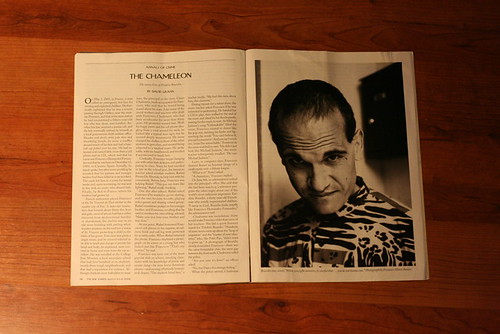From a New Yorker article about the French serial imposter Frédéric Bourdin (nicknamed “The Chameleon”):
…he tried to elevate his criminality into an “art.” First, he said, he conceived of…whom he wanted to play. Then he gradually mapped out the character’s biography, from his heritage to his family to his tics. “The key is actually not lying about everything,” Bourdin said. “Otherwise, you’ll just mix things up.” He said that he adhered to maxims such as “Keep it simple” and “A good liar uses the truth.” In choosing a name, he preferred one that carried a deep association in his memory….He compared what he did to being a spy: you changed superficial details while keeping your core intact.
This, too, is what the writer does…

I read this article at lunch the other day. One of the more interesting things I’ve read in the New Yorker lately, and yes, I think you’re completely right about the parallel to writing.
Have you seen Orson Wells’ movie about El Mir? What’s the title??.. “F is for Fake”, I think.
At any rate, the subject matter is along these lines. I liked it very much.
Matt: the NYer is about the only thing I read these days (and will probably be so until the book is finished) Its folds nice and neat on the bus, and it fits in my back pocket.
John: nope, never seen it. Will see if I can netflix it.
Sounds like an article to read. What does the difference make here? For example this guy has (haven’t read the article so completely riffing) an element of danger intrinsic in his actions, his life. The writer has no immediacy like this. Would the element of greater risk enhance the writing experience?
The risk in a con is being discovered as a fraud.
The risk in writing is being discovered as a fraud.
The “immediacy” springs from constructing the fiction, pushing it to that edge of danger.
Nice. I can go with that.